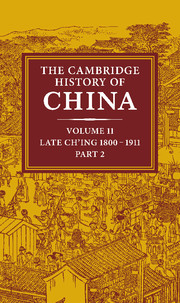Book contents
- Frontmatter
- 1 Economic trends in the late Ch'ing empire, 1870–1911
- 2 Late Ch'ing foreign relations, 1866–1905
- 3 Changing Chinese views of Western relations, 1840–95
- 4 The military challenge: the north-west and the coast
- 5 Intellectual change and the reform movement, 1890–8
- 6 Japan and the chinese revolution of 1911
- 7 Political and institutional reform 1901–11
- 8 Government, merchants and industry to 1911
- 9 The republican revolutionary movement
- 10 Currents of social change
- Bibliographical essays
- Bibliography
- Index
- Map 1. Ch’ing empire – physical features
- References
3 - Changing Chinese views of Western relations, 1840–95
Published online by Cambridge University Press: 28 March 2008
- Frontmatter
- 1 Economic trends in the late Ch'ing empire, 1870–1911
- 2 Late Ch'ing foreign relations, 1866–1905
- 3 Changing Chinese views of Western relations, 1840–95
- 4 The military challenge: the north-west and the coast
- 5 Intellectual change and the reform movement, 1890–8
- 6 Japan and the chinese revolution of 1911
- 7 Political and institutional reform 1901–11
- 8 Government, merchants and industry to 1911
- 9 The republican revolutionary movement
- 10 Currents of social change
- Bibliographical essays
- Bibliography
- Index
- Map 1. Ch’ing empire – physical features
- References
Summary
INTRODUCTION: TRADITIONAL VIEWS OF FOREIGN RELATIONS
China's invaders in the nineteenth century left a more extensive record than anything we are as yet aware of from the Chinese side. After all, success makes a good story. Exploits and impressions on the expanding frontier of the international trading world were variously recorded by travellers, diplomats, missionaries, journalists and others in a flood of correspondence, articles and books now available in Western libraries and archives. The Chinese who suffered invasion, on the other hand, had little but oddities, fears and disasters to record. The story of the foreign intrusion on the whole was unpleasant and humiliating. Moreover, it was known directly to only a few of the ruling class, literati and officials, while the commoners, especially those who worked with foreigners, were not accustomed to writing down their views and experiences for posterity. Consequently in examining Chinese views of the West we are obliged to rely primarily on upper-class writings by scholars who were thoroughly indoctrinated in the Chinese classical teachings and therefore least likely to depart from traditional attitudes towards foreigners.
In addition, China's perception of Western relations during the Ch'ing period was influenced by certain considerations peculiar to the ruling Manchus, who came from an area that differed significantly from China proper. The economy of Manchuria, for example, was semi-nomadic, based originally on a mixture of hunting, fishing and animal husbandry that was fundamentally different from the sedentary and agricultural economy of China. The Manchus therefore paid particular attention strategically to the nomadic societies of Mongolia, Sinkiang and Tibet, which shared certain basic characteristics with Manchuria.
- Type
- Chapter
- Information
- The Cambridge History of China , pp. 142 - 201Publisher: Cambridge University PressPrint publication year: 1980
References
- 24
- Cited by

